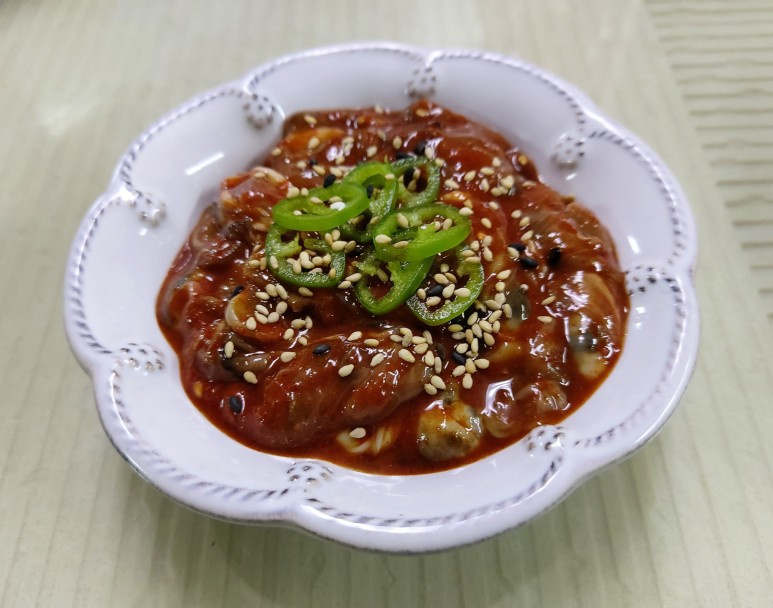Authentic Korean Pickled Oysters (Eoriguljeot)
Golden Recipe for Delicious Homemade Eoriguljeot

With oysters in season, it’s the perfect time to make this exquisite Korean delicacy! After enjoying oysters in various dishes like soup, rice, or savory pancakes, you might have some left. This recipe transforms leftover oysters into a delightful fermented condiment, Eoriguljeot. Making this dish brings back fond memories, reminiscent of mother’s cooking. Experience the unique chewy texture and rich umami flavor that makes this a must-have side dish, especially with a bowl of warm rice.
Main Ingredients- Fresh Oysters: 300g
- Lemon Juice: 1 Tbsp
- Coarse Sea Salt: 1 Tbsp
Seasoning- Fine Gochugaru (Korean Chili Flakes): 4 Tbsp
- Minced Garlic: 1 Tbsp
- Ginger Powder: a pinch
- Maesil Cheong (Plum Extract): 1 Tbsp
- Fish Sauce (Anchovy or Pollack): 1 Tbsp
- Honey: 1 Tbsp
Rice Flour Paste- Sweet Rice Flour: 2 Tbsp
- Kelp Broth (cooled): 60ml
- Fine Gochugaru (Korean Chili Flakes): 4 Tbsp
- Minced Garlic: 1 Tbsp
- Ginger Powder: a pinch
- Maesil Cheong (Plum Extract): 1 Tbsp
- Fish Sauce (Anchovy or Pollack): 1 Tbsp
- Honey: 1 Tbsp
Rice Flour Paste- Sweet Rice Flour: 2 Tbsp
- Kelp Broth (cooled): 60ml
Cooking Instructions
Step 1
Gently rinse the fresh oysters under running water while they are in a colander. Carefully roll and wash them to remove any shell fragments or impurities. Repeat this rinsing process about twice for thorough cleaning.

Step 2
After rinsing, add 1 Tbsp of lemon juice to the oysters and gently mix. Rinse them once more. The Vitamin C in lemon juice helps prevent nutrient loss and aids absorption. After rinsing, drain the oysters completely to remove excess water.

Step 3
Add 1 Tbsp of coarse sea salt to the drained oysters. Gently toss to coat, ensuring the salt dissolves and begins to cure the oysters. This step draws out moisture and enhances their natural flavor.

Step 4
Transfer the salted oysters to a clean container. Cover it with a lid or plastic wrap, and refrigerate for 3 days to ferment. This aging process develops the deep, complex flavors characteristic of Eoriguljeot.

Step 5
Prepare the rice flour paste. In a small pot, combine 2 Tbsp of sweet rice flour with 60ml of cooled kelp broth. Stir continuously over low heat until a slightly thickened, smooth paste forms, ensuring there are no lumps. Let it cool completely before use.

Step 6
Make the seasoning mixture. To the cooled rice flour paste, add 4 Tbsp of fine gochugaru, 1 Tbsp of minced garlic, a pinch of ginger powder, 1 Tbsp of maesil cheong, and 1 Tbsp of fish sauce. Mix well to create the flavorful base for the Eoriguljeot.

Step 7
During the fermentation period, some liquid may accumulate at the bottom of the container. This liquid can affect the final taste, so carefully drain it away before mixing in the seasoning. This ensures a cleaner flavor profile.

Step 8
Now, it’s time to combine the oysters with the seasoning. Add the prepared seasoning mixture to the fermented oysters. Gently mix everything together, being careful not to break the oysters apart. Ensure the seasoning coats each oyster evenly.

Step 9
Taste the mixture and adjust the saltiness with more coarse sea salt if needed. Finally, stir in 1 Tbsp of honey. The subtle sweetness from the honey enhances the overall flavor, adding a delightful depth and balance to the Eoriguljeot.

Step 10
While you can enjoy it immediately, for a richer and more developed flavor, let the Eoriguljeot further mature in the kimchi refrigerator for an additional 3-4 days. This allows the flavors to meld beautifully.

Step 11
After 3-4 days, finely chop some Korean chili peppers and add them along with toasted sesame seeds. Mix gently. The result is a fresh, non-salty Eoriguljeot with absolutely no fishy taste and a wonderfully chewy texture, unlike any store-bought version. It’s a true delicacy, perfect for spooning over a hot bowl of rice, making it an irresistible ‘rice thief’!



